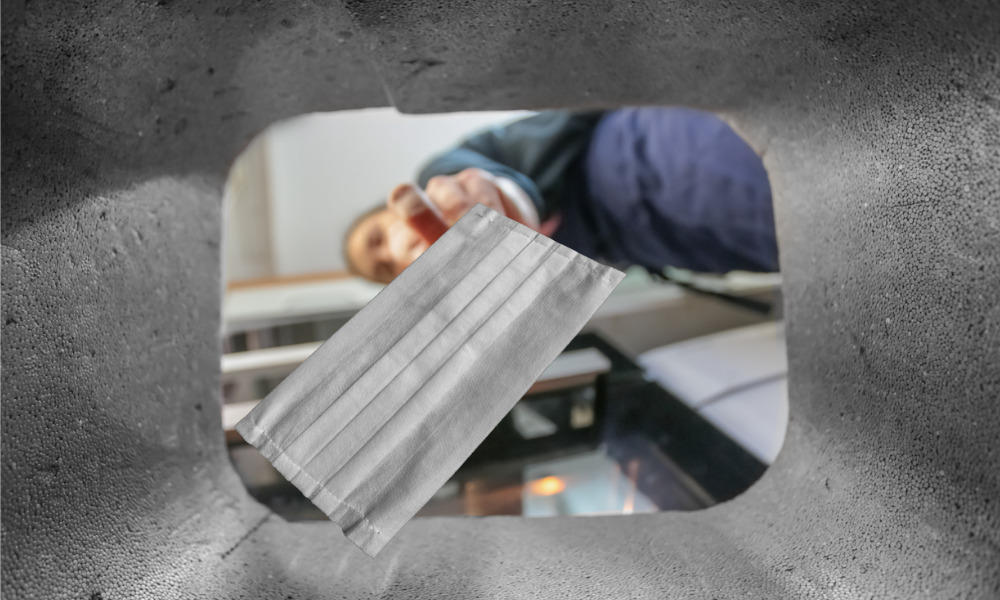Safely getting rid of PPE is almost as important as wearing it

While acquiring PPE seemed to be the big issue for employers across Canada in 2020, disposing of PPE seems to be gaining traction as a topic of interest in 2021.
Face masks and respirators are currently mandated across much of Canada as part of the bid to curb the spread of COVID-19. Other bits of PPE such as face shields or gloves are also very common, notably for those working in healthcare, manufacturing or in grocery stores.
Waste management
Even outside of the pandemic, proper waste management and disposal is paramount in a number of industries – think of, for example, butchers or bakers handling food (not to mention, food waste).
Currently, used face masks (and other PPE) are generally considered as hazardous waste due to the infectious nature of COVID-19. Subsequently, employees and employers should correctly understand how to dispose of PPE in the safest way possible.
Here are five tips to consider when handling PPE.
1. Use a closed-lid receptacle
According to the World Health Organization (WHO), PPE needs to be disposed of in a closed-lid receptacle rather than a regular bin precisely because we need to treat COVID-19 related PPE as infectious or hazardous waste.
READ MORE: 10 Canadian brands making face masks to support
2. Dedicate bins for contaminated PPE
Another thing that workplaces can do is makes sure that there are bins in the workplace that are dedicated to PPE disposal. If necessary, use signage in multiple languages to ensure that all staff are aware of which bins to use.
Having a clearly marked bin will make it easier for employees to know where to dispose of their PPE, and prevent them from disposing of their mask or gloves in a regular bin, which could lead to others coming into contact (knowingly or unknowingly) with potentially infectious waste.
This is paramount for the safety of not only other employees, but sanitation staff as well.
3. Prevent overflowing of disposals
Citron, a hygiene services provider, says on their website that overflow promotes littering, as it provides a negative example to others on how to dispose of PPE.
Furthermore, they say that the best way type of bin is touch-free, as manually opening a bin could lead to the user touching a potentially contaminated surface.
CleanRiver, a provider of recycling and sanitation solutions, concurs and says that users should keep receptacles from overflowing to allow for easy removal and closure of the waste bin liner, and preventing others from having to come into close contact with used PPE.
READ MORE: What you need to know about air circulation amid COVID-19
4. Educate employees on removing PPE correctly
But before the PPE even hits the bin, employees should know how to safely and hygienically remove PPE. The best prevention is education. Communicate with employees through (socially distanced) in-person meetings, video calls or email. Implement signage (in multiple languages) around the workplace to ensure that employees have clear, written instructions at their disposal.
So how exactly should employees remove their PPE?
According to the Centers for Disease Control and Prevention (CDC), the user should avoid touching the front of the mask or respirator as it is considered as contaminated.
“If your hands get contaminated during mask/respirator removal, immediately wash your hands or use an alcohol-based hand sanitizer,” says the CDC.
The wearer should then grasp the ties or elastic of the mask or respirator, then the ones of the top and remove without touching the front. Then the wearer can discard the mask/respirator in the correct bin.
After removal, you should always wash your hands with an alcohol-based sanitizer immediately.
READ MORE: Draining, the forgotten player in the fight against COVID-19
5. Disinfect units
Lastly, increased surface hygiene should be a part of every company’s COVID-19 response plan.
This includes regularly and safely cleaning PPE disposal bins using disinfectant to kill any potential germs.
Whoever is cleaning the PPE disposal bins should wear adequate PPE to avoid the possibility of being contaminated.
For those working from home, safely and hygienically disposing of PPE is equally as important, and teleworkers should consider implementing these steps in their homes.
Environmental impact
On top of this, there are also questions around mitigating PPE waste. Indeed, numerous reports have indicated that discarded masks or gloves (which are single-use) could be having a negative impact on the environment.
“Over 63,000 tons of Covid-19 related single-use masks and respirators will be used over the next year in Canada, significantly contributing to the pollution in our landfills and oceans,” said Mikhail Moore, president, Vitacore, to COS.
As a response, companies are stepping up with green initiatives such as Vitacore, a Canadian face mask company which has launched a recycling program, or the borough of Saint-Laurent in Montreal, which announced in November that it had created a way for residents and municipal workers to recycle PPE.





